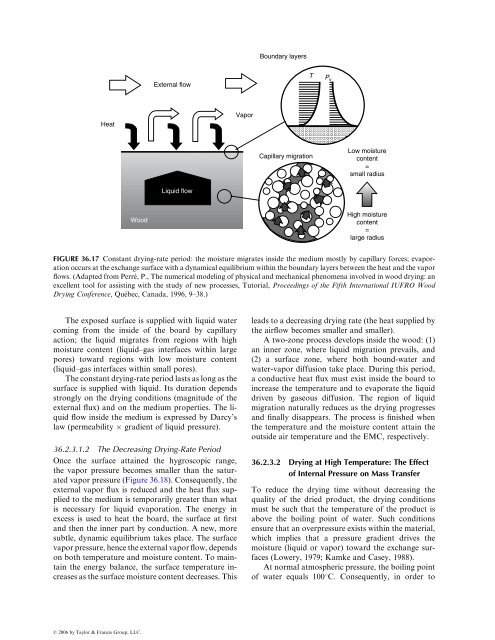36 Drying of Wood
36 Drying of Wood
36 Drying of Wood
- No tags were found...
Create successful ePaper yourself
Turn your PDF publications into a flip-book with our unique Google optimized e-Paper software.
Boundary layersExternal flowTP vHeatVaporCapillary migrationLow moisturecontent=small radiusLiquid flow<strong>Wood</strong>High moisturecontent=large radiusFIGURE <strong>36</strong>.17 Constant drying-rate period: the moisture migrates inside the medium mostly by capillary forces; evaporationoccurs at the exchange surface with a dynamical equilibrium within the boundary layers between the heat and the vaporflows. (Adapted from Perré, P., The numerical modeling <strong>of</strong> physical and mechanical phenomena involved in wood drying: anexcellent tool for assisting with the study <strong>of</strong> new processes, Tutorial, Proceedings <strong>of</strong> the Fifth International IUFRO <strong>Wood</strong><strong>Drying</strong> Conference, Québec, Canada, 1996, 9–38.)The exposed surface is supplied with liquid watercoming from the inside <strong>of</strong> the board by capillaryaction; the liquid migrates from regions with highmoisture content (liquid–gas interfaces within largepores) toward regions with low moisture content(liquid–gas interfaces within small pores).The constant drying-rate period lasts as long as thesurface is supplied with liquid. Its duration dependsstrongly on the drying conditions (magnitude <strong>of</strong> theexternal flux) and on the medium properties. The liquidflow inside the medium is expressed by Darcy’slaw (permeability gradient <strong>of</strong> liquid pressure).<strong>36</strong>.2.3 .1.2 The Decr easing <strong>Drying</strong>- Rate Pe riodOnce the surface attained the hygroscopic range,the vapor pressure becomes smaller than the saturatedvapor pressure (Figure <strong>36</strong>.18). Consequently, theexternal vapor flux is reduced and the heat flux suppliedto the medium is temporarily greater than whatis necessary for liquid evaporation. The energy inexcess is used to heat the board, the surface at firstand then the inner part by conduction. A new, moresubtle, dynamic equilibrium takes place. The surfacevaporpressure,hencetheexternalvaporflow,dependson both temperature and moisture content. To maintainthe energy balance, the surface temperature increasesas the surface moisture content decreases. Thisleads to a decreasing drying rate (the heat supplied bythe airflow becomes smaller and smaller).A two-zone process develops inside the wood: (1)an inner zone, where liquid migration prevails, and(2) a surface zone, where both bound-water andwater-vapor diffusion take place. During this period,a conductive heat flux must exist inside the board toincrease the temperature and to evaporate the liquiddriven by gaseous diffusion. The region <strong>of</strong> liquidmigration naturally reduces as the drying progressesand finally disappears. The process is finished whenthe temperature and the moisture content attain theoutside air temperature and the EMC, respectively.<strong>36</strong>.2.3 .2 Dry ing at High Temper ature: The Effect<strong>of</strong> Inter nal Pressur e on Mass Tr ansferTo reduce the drying time without decreasing thequality <strong>of</strong> the dried product, the drying conditionsmust be such that the temperature <strong>of</strong> the product isabove the boiling point <strong>of</strong> water. Such conditionsensure that an overpressure exists within the material,which implies that a pressure gradient drives themoisture (liquid or vapor) toward the exchange surfaces(Lowery, 1979; Kamke and Casey, 1988).At normal atmospheric pressure, the boiling point<strong>of</strong> water equals 1008C. Consequently, in order toß 2006 by Taylor & Francis Group, LLC.
















